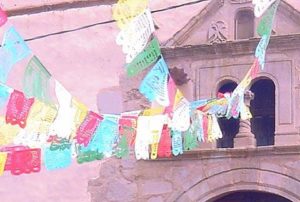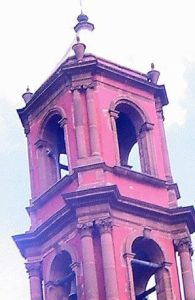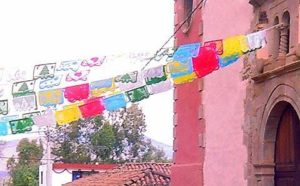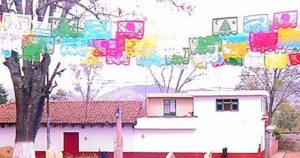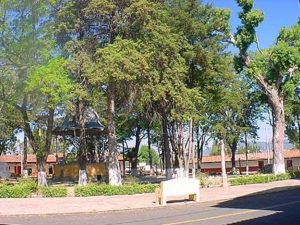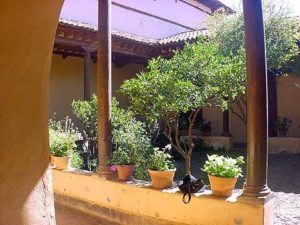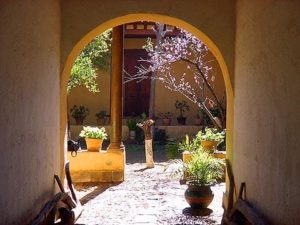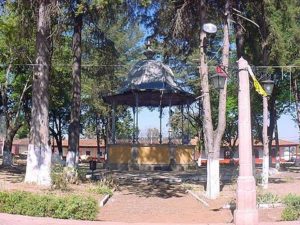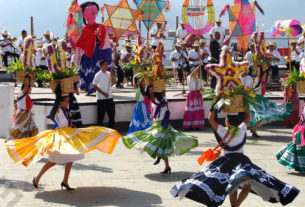The town had been sort of a laughing stock, ignored by outsiders,one of those dusty lonely little burgs where no one seemed particularly interested in much beyond survival. Like sad and decrepit towns scattered across rural America – towns named Promise City, Gravity, and Dumas – its inhabitants bore looks of quiet desperation. Tzurumútaro was one of those towns that time – and everyone else – forgot.
Unlike the neighboring villages which line the shores of Lake Pátzcuaro, Tzurumútaro harbored no archeological ruins like Tzintzuntzan and Ihuatzio, produced no spectacular artesania like Tocuaro and Santa Fe de la Laguna, and hosted not even a weekly tianguis or a full-time priest. Hard work in the surrounding fields and an indomitable spirit marked this town of a few thousand souls more than any other cultural attribute. In recent years, its more prosperous inhabitants had small businesses lining the highway, but most of the town hied to Pátzcuaro or Morelia for work.
A curious visitor, exploring towns around Lake Pátzcuaro, might be attracted to a church spire piercing the sky, drive in once to explore, and never venture back. I first visited the town, just because it looked interesting back around 1981, and despite driving past it hundreds of times since, I didn’t stop back in for another nineteen years.
The town had a “Twilight Zone” feel, as if people lived there but no one was ever around. Even the plaza was deserted at high noon. Only its cemetery, not much different from any other small Michoacán town’s cemetery, ranked a passing mention in standard-issue guidebooks. And that was only because Tzurumútaro was on the Noche de Muertos route between its better-known cousins along the lake.
What the town did have was attitude. The community, which existed long before the Spaniards set foot in the New World, was the subject of dispute between Tarascan factions long before it was “officially” founded around 1522 by Fray Martin de Jesus, also known as Fray Martin de la Coruña, who thought the town ought to be named San Pedro, after its patron saint. The locals didn’t much care for that appellation, and so the time-honored name of Tzurumútaro, which came from the Tarascan word “sirimuta,” meaning a thorny plant from which rope was made, stuck.
Still a strong-headed lot, the Purèpechas of this town purportedly mixed in with some wandering Yaquis and Zapotecs, although no one is quite sure how or why they reached the shores of Lake Pátzcuaro. Some authorities deny it all, and others suggest the outsiders came to town as part of an early guest worker program.
Tzurumútaro’s populace didn’t openly accept the ministrations of the kind and well-intended Christian brothers. Frankly, they were a little suspicious. One of the fables that’s whispered in the area claims that after the town’s rebellious folks did some major damage when they dragged Catholic icons through muddy lanes, the town was cursed and became known as the Village of the Damned. But you know how these rumors start, just like Salem’s witch trials. At any rate, that was long ago, and there are no living eyewitnesses, or even anyone with good first-hand information. It’s still a good tale just the same.
Of course, the Church prevailed and persevered, building again. And the curse, if there ever was one, sort of fell by the wayside.
The scrappy attitude of the campesinos continued, becoming one of the more radical groups in Mexico during the past century. A brand-new kiosko, or bandstand, built in 1905 to reign over the plaza just wasn’t enough. The people wanted their share of the basics: education, better irrigation systems for their fields, credit opportunities, modern agricultural technology, and, most of all, destruction of the latifundios (large landholdings). Organized, the Tzurumútarenses grabbed the attention of Lazaro Cardenas, reclaiming some 1605 hectares from adjacent haciendas. Today their dedication to the agrarian movement, heavily fueled by the efforts of the Liga Feminil Agrarista, can be seen in the town’s Agrarian Museum and their annual ofrenda in honor of Tata Cardenas.
All of that changed during the summer of 2000, when the 11th World Scout Moot Mundial Mexico 2000 met in Mexico. Five thousand men and women, ranging in age from 18 to 25 years, gathered in Mexico City before heading off to Pachuca, Puebla, Tepoztlan, Morelia, Queretaro and Guanajuato. In addition to the usual slate of recreational and cultural activities, part of the Scouts’ program involved reaching out and performing good works in communities they visited, carrying out the Moot’s theme of “Tradition for Tomorrow.”
For six consecutive days, a Babel of some 1,260 scouts, working in crews of 210 each day, descended upon the Tzurumútaro, armed with shovels, axes, trowels, brooms, and paintbrushes, laboring as they dug ditches, shoveled out the detritus of years gone past, shored up decrepit buildings, plastered and painted the town in hues of ladrillo and white. Various government agencies contributed $282,858 Mexican pesos (around $30,000 USD, which isn’t really very much when it’s government money) toward the materials which gave the town a complete facelift. This army of scouts, hailing from 75 countries across the planet, worked with such enthusiasm that the locals were spurred to pitch right in.
These Scouts resembled nothing like the images I’d harbored of a square-knotted and now politically incorrect bunch portrayed in the American media. These were a hip group, toting Day-Glo backpacks, shod and clad in tones that last saw the light of day back in the ’60s, sporting spiky bleached hair and ponytails, earrings and freaky bandanas, somehow communicating in the official languages of English, Spanish and French.
Tzurumútaro would never be the same after the Scouts left. Those sparks of sweat and energy infused the town with renewed pride and self-esteem, and the town continued its renovation with just a little bit of help from the government. The look on the locals’ faces changed from that quiet kind of bored resignation to smiles. Even the dogs loafing on the plaza seemed just a little perkier. The seeds for that field of dreams had been planted.
Pátzcuaro had long been ground zero for Noche de Muertos celebrations, tourists making the pilgrimage from all over the world. And frankly, it was getting a little crowded, and to some, a tad commercial. Down the road, Tzintzuntzan held the reputation for the best Noche de Muertos festivities. And there was a town right at the crossroads, at the Y intersection of the highway from Morelia. That town was Tzurumútaro. After all, its cemetery was always listed in those guidebooks as a designed Noche de Muertos venue.
Why not establish sustainable tourism in Tzurumútaro, thought the persons in charge of thinking up these projects. Noche de Muertos 2000 seemed a natural, but why stop there? The combined efforts of Michoacán Secretary of Tourism Ana Compean Reyes Spindola and her assistant Marina Villalobos Diaz, joining forces with the community of Tzurumútaro, the city of Pátzcuaro, the National Institute of Anthropology and History, and a host of other governmental and non-governmental agencies, worked to make this town a year-round forum for artistic creativity, regional food, and tourism.
Noche de Muertos became the more than just a two-night event, spreading itself over five days in a festival of regional music, dance, craft market, and food during the First Tourism, Artisan and Gastronomic Tianguis held from November 1 through 5, 2000. Arts and crafts ranging from natural remedies to rattan baskets and pottery sold like crazy in the covered market, displayed with somewhat more care and less commercialism than in the huge plaza in Pátzcuaro. Tiny lakeside burgs not usually well-represented, if at all, in Pátzcuaro’s marketplace offered up a variety of crafts. There might not have been wide range of wares, but the vendors even ran out of merchandise!
The gastronomic center was an even greater surprise. Behind the city buildings facing the square was a huge open lot dedicated as restaurant where plaid tablecloths covered tables under the protection of a giant tent. Operating at full capacity from breakfast until night, this production was no mere church supper. Not taking any chances, our party of two Mexicans and two gringas was greeted in English. The waitstaff, locals, were identified by nametags and actually knew how to serve tables! We wondered how many were destined for jobs in fancy restaurants off in Morelia before long.
It wasn’t enough to simply sit and order from a fairly extensive menu. I had to wander and inspect the outdoor kitchens. Adobe fogones and hornos had been built just for the occasion and in traditional styles. Local women clapped out tortillas in the true hecho a mano style, using no presses, while others ladled out café de olla from bubbling ollas. Still others wound up those sextahedronal (six sides, five points) corundas in corn leaves, the blind tamale of Michoacán. And even more of the cooks stirred cazuelas of mole de pollo and fried fish.
Throughout the town rang dulcet and merry tones throughout every day of the celebration, ranging in style and repertoire from the Banda de Tzurumutaro, Bola Suriana, Violines Michoacános, Grupo Purembe, Dueto Zacán, and a chamber group. Even the Ballet Folklorico performed. Festivity was in the air.
But sometimes even the best can be overshadowed by the urgent needs of parking and bathrooms. Not here. We were guided to a parking space just a block away from all of the action, and the bathrooms were the cleanest and most plentiful I have ever seen at any public event in all of Mexico. Not a single bit of the necessary and unglamorous infrastructure had been forgotten.
Representatives from the state tourism office, as well as Mexican Scouts hailing from more than a hundred miles away, were in force, personally welcoming guests to the celebration with the hospitality and friendliness that made everyone feel right at home. Inside city buildings commandeered for the celebration were before-and-after shots of the town’s transformation, as well as displays of what’s on the drawing board.
Having garnered acclaim in the Mexican Catalog of Successful Examples of Sustainable Tourism for 2000, the Tzurumútaro project is only in its initial phase. The second stage, the tianguis gastronomico is already in operation, serving up traditional regional foods in a relaxed, clean and attractive setting every weekend, has already started. Plans are already afoot to create a permanent arts and crafts market, encouraging a regular slate of cultural events.
Of course, we all know that the thrust behind tourism isn’t entirely eleemosynary in its intent to provide entertainment for tourists. It’s a matter of bringing money into the community, providing jobs, and continuing cultural traditions. The coordinated efforts of everyone involved in Tzurumútaro’s transformation delivered more than just industry; those efforts brought respect and self-esteem to its people, something that simply can’t be measured in dollars and pesos.
The federal Secretary of Public Education (SEP) installed a Mision Cultural, one of twenty developed in Michoacán during the past quarter-century, in the town to foster and encourage adult education in a broad spectrum from music, beauty, candy-making to carpentry. Within the first three months of its operation, 260 adults had enrolled.
In the past six months, I’ve returned again and again to Tzurumútaro, making it a regular stop on each trip to Pátzcuaro, insisting that even people who live in the area visit this once-forgotten town. Even Jean, a cultured and knowledgeable kind of person after teaching all those years at the university right here in Morelia, who thinks nothing of hopping on a bus to Mexico City for the day just to see how the very Chinese art she’d seen in China looked at some exhibition in Mexico, asked “Where’s Tzurumútaro?”
Just last week, I stopped by when I spied a parade in progress. One of the old men on the plaza waved a greeting at me and then asked the parade to slow down while I fumbled with my camera. Now, I’ve been to lots of small towns in central Mexico, but the only greeting I’ve ever received was from the police or a kid selling Chiclets. The townsfolk in Tzurumútaro waved and talked to me like they knew me. My ego was pumped. Obviously, there aren’t too many blondes wearing Mephistos driving a plum Eldorado around these parts, but I had a sense that a renewed generosity of spirit would reach out to all folks who venture into Tzurumútaro today.
There’s no experience as enriching, or disappointing, as venturing out into small town Mexican communities. Frankly, in some small Mexican towns a foreign license plate, which might be from Texas or Tabasco, elicits the same welcome that a wandering Hassid might receive in Hiawatha, Kansas. Conversation sort of comes to halt, the locals stare, and there’s a sense of intrusion. You get that feeling that perhaps it’s best that you simply move on. Moreover, there’s often some doubt as to where to eat. A visit to Tzurumútaro just isn’t like that. While it hasn’t transformed itself, and likely will not, into a colonial Williamsburg or a stage set, it’s a sure bet that a visitor will feel welcome here, will eat well, and will find something to do.
Tzurumútaro was a town with a past, and now it’s a town with a future.
GETTING THERE
From Morelia, it’s a 35-mile drive to Pátzcuaro. Tzurumútaro is just two miles before Patzcuaro. Buses run fairly frequently between Tzurumútaro, Pátzcuaro and Morelia.
WHERE TO STAY
See ” Lodging in and around Pátzcuaro, by jennifer j. rose, Mexico Connect 1998,
Since that article was written, even more hostelries have opened up.
Hacienda Mariposas. Small country inn on 18 forested acres. $85 USD and up. From the US: (800) 573-2386 or (707) 573-8644. Fax (707) 575-1166. From within Mexico: 001 800 573 2386 or (434) 24728 [email protected] https://www.haciendamariposas.com/
Casa Brunson. 3-room colonial bed & breakfast. $80 USD and up. Dr. Coss #13, Pátzcuaro. Adjacent to Once Patios. Tel 011-52-4-342-3903 [email protected]
Hostal del Valle. Small hotel. $45 USD. Lloreda #27, Pátzcuaro. @ blocks from the downtown plaza. 011-52-4-342-0512 [email protected]
WHERE TO EAT
If you’re going to be in Tzurumútaro during a weekend or other occasion when the Tianguis Gastronomico is being held, where else would you eat?
My favorite alternative is the Restaurant Camino Real, located just beyond town on the road to Pátzcuaro, just before the Pemex station. Open daily from 7 a.m. to 11 p.m., it’s not unusual to find people waiting in line for down-home repasts. Don’t be fooled by the exterior, because inside you’ll find a nod to seasonal décor, uniformed waiters, and tablecloths. The four-course comida corrida is a genuine bargain at $35 pesos.
MUSEO AGRARISTA
Somehow this museum isn’t only about agriculture. Right up next to the church, in a neatly courtyarded dwelling once used as the priest’s living quarters, is a small, intimate and well curated array of documents, farm implements, paintings and engravings focusing upon the area’s agriculture. Within its four exhibition rooms are permanent exhibitions devoted to Zapata, Cárdenas, and Morelos, the really big names in the agrarian reform movement, but more importantly can be found the sense of the community to whom it all belongs. While it doesn’t put on any airs or hold forth with the intellectual pretense that marks a lot of museums, this family-oriented repository of history is the perfect stopping place just to observe what a genuine rural middle-class kitchen or bedroom might resemble, to soak up a feel for rural Mexico and its struggles, and to contemplate the past as well as the future.
Open Tuesday through Friday from 9 a.m. to 2:00 p.m. and from 4 p.m. to 6 p.m. Saturday and Sunday, from 9 a.m. to 2 p.m.
Admission free.
Raquel, the caretaker, is a delightful resource. Say hello to her, and her helpful two-year old son, Jose Luis.


